#nectivore
Explore tagged Tumblr posts
Text
Bracket Winner: Pretty Birds
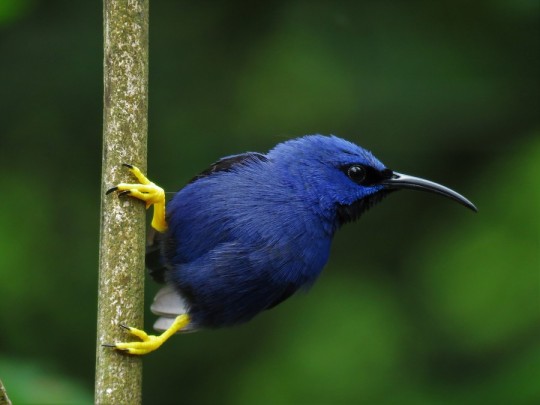

Purple Honeycreeper (Cyanerpes caeruleus)
Cyanerpes, from the Ancient Greek 'kuanos' meaning "dark-blue" and 'herpes' meaning "creeper"; caeruleus meaning "dark blue" in Latin-- so basically this is a "dark-blue creeper who is dark-blue"
eBird sightings: 29,552; IUCN Redlist Rating: Least Concern
Beaten: Pink Robin, Bluethroat, Bohemian Waxwing, Violet Turaco, Long-tailed Minivet
This species forages in small groups, often feeding on nectar, fruits, and occasionally on insects and seeds. The curve of their bill is adapted for feeding on bromeliad flowers and their nectar.
This species is very inquisitive and will respond to predatory calls by coming out of their cover and searching for the predator so they can mob it. Mobbing is when a smaller animal attempts to "beat up" and bully a predatory animal into leaving the area. Its often annoying enough to work.
Sources under the cut
Images: male & female by Mike Hudson
#hipster bird bracket winner#purple honeycreeper#cyanerpes caeruleus#thraupidae#passeriformes#nectivore#frugivore#insectivore#south american birds
18 notes
·
View notes
Text

Starting Pantala off strong with the SilkWings!
You know how it it. Joy and Tui yes, me no. Just adding my flair.
Details and explanation below.
Otherwise, next week are HiveWings! See you then!
More overcomplicated dragons.
Ramble time.
Given how Tui based the Pantalan tribes off insects (and I have a few words on that later-) I wanted a similar design feature to unite and separate the Pantalan tribes from the Pyrrhian. Where the Pyrrhian tribes are all reptilian based, the Pantalan tribes have a bit of bird thrown in there. They're all going to have a beak-like structure to their snout which is supposed to be a mix of beak and bug mandibles.
To start, for the SilkWing beak, I heavily referenced bees. The shape of their beak emulates that of a honeybee from the side. Even their tongue is based on a honeybee's, as I thought they naturally fit into a nectivorous lifestyle. This comes more from the butterfly side of Tui's design influences, as well as the popular honeydrop treats they like. (I just checked the wiki to verify that they're vegetarian; lo and behold, it says they eat nectar. You need the proper tongue for that!)
That being said, if Pantala has giant carnivorous plants... can't it have giant flowers too?
But in canon SilkWings don't just eat nectar. They eat fruits and some vegetables. Those require proper teeth to chew them so I based them off of fruit bat teeth.
Oh, and, I'm sure you've noticed the scales by now. I always loved the way Blue and Luna's covers looked, specifically Luna's and the way her scales are really shiny like beetle elytras. I did my best to emulate the way light bounces and reflects, even down to the little bumps and ridges. This dragon isn't as dark as it looks, is what I'm trying to say, it's just a result of the way its scales reflect light.
And, speaking of the scales, I referenced pangolins! Among being a perfect reference they are also the most highly trafficked animal in the world, which sort of fits for SilkWings............ I didn't write Pantala's lore. :|
That's all! See you next week for the HiveWings!
#wof#wings of fire#wof art#art#my art#digital art#silkwing#wof silkwing#wof fanart#Overcomplicating the WOF Tribes
368 notes
·
View notes
Photo

Is that a mouse?🐭 Guess again: This pocket-sized critter is the western pygmy possum! (Cercartetus concinnus). One of the world’s smallest possums, this species typically weighs just 0.5 oz (13 grams)— the size of an AA battery. This dainty marsupial is a nectivore, meaning that its diet consists primarily of plant nectar. It inhabits treetops in forests throughout parts of southern Australia, using its long prehensile tail like a fifth limb as it moves from branch to branch. Photo: latcho, CC BY-NC 4.0, iNaturalist #nature #animals #amazinganimals #natureisawesome #wildlife https://www.instagram.com/p/CpiJrz6NSbo/?igshid=NGJjMDIxMWI=
1K notes
·
View notes
Text

An esoblep enjoying a tasty snack of nectar, and one trying to gnaw on soap because it just smells so good.
They are a small and fast species of blep, with a keen sense of smell and a curious personality. They are mostly nectivorous but also eat juices from fallen fruit on occasion. Notorious for their ability to get inside houses, a specific breed of Nium exists to lure them back outside. They are desired in fields of crops with large, showy flowers, and are important pollinators for these.
Bonus pic of an old-ish drawing that i somehow never posted on this blog?? oh well

#okali#fantasy#wandering okali#species#art#graphi's things#worldbuilding#speculative biology#specbio#xenobiology#creature design
191 notes
·
View notes
Text

Well, here's the food I wanted to worldbuild!
I've been thinking of having daphnia, a small aquatic arthropod, be a stand-in for fish for Hollow Knight worldbuilding since an actual fish would be similar to the size of a whale. Daphnia would be pretty wide spread and can be found anywhere with a large enough body of freshwater. Because of their large range, different ways of preparing them are found in different areas or civilizations, even differing between species in the same area to meet their nutritional and digestive needs.
For example, in my paper-wasp kingdom Hymecria, most daphnia-based dished have the meat cooked, as adult wasps have a difficult time breaking down protein compared to when they were still larvae. They also often include a sweeter, fruity element to the dish as adult wasps are mainly nectivorous. Meanwhile, in the lakeside town where Kayzen grew up, many daphnia dishes include serving them raw as dragonflies like himself are carnivorous at all stages of life, and can easily digest raw meat. They do have dished that call for cooking the daphnia as well, as cooking something is a great way to introduce new flavours or textures, with daphnia leg tempura being a favourite crunchy snack. Finally, insects that are omnivores often incorporate pieces of daphnia into dishes alongside other ingredients, creating a balanced set of nutrients for them in their meals. The ratio of daphnia or other meat products to more herbivorous ingredients varies between recipe, species, and even just personal preference.
#my art#my ocs#kayzen#worldbuilding#id in alt text#hollow knight#hollow knight worldbuilding#hollow knight food#this was a lot of fun to do#I especially like the idea of a tomato-equivalent in hollow knight being called acid berries#because that's kinda what tomatoes are if you think about it
7 notes
·
View notes
Text
youtube
Josh creates habitat for insects, birds, and lizards in his garden by planting an array of native plants and building some simple structures for shelter and water.
‘I’ve always seen our garden as shared space. I don’t just mean for friends and family, but for wildlife too.’
Over the years Josh has put in the effort to accommodate biodiversity into his garden, creating many projects such as nesting boxes, bird baths, native plantings, frog ponds, insect hotels and more. Gabion structures create heaps of hiding spots for insects, logs and boulders provide basking areas for skinks, and there is even a nest box for pardalotes. But aside from these structures, it is the plants that underpin everything—native plants! If you want to support wildlife, native plants can provide a food source for them. If this is one of your goals, it is important to think about having food available throughout the year.
Josh’s native habitat verge aims to provide this, with grevilleas as a source of nectar for nectar-feeding birds. The coastal sword sedge produces seed as a food source, and the local eucalypts house heaps of insects, which are eaten by insectivorous birds. The key is diversity in species and in structure—understory, midstory, overstory.
There are a few areas in Josh’s verge plantings that need a little touch-up and accentuation. Josh will first assess what is working in the verge, and what needs some attention. They will start with some maintenance to existing plants, then install simple habitat structures, and lastly plant out some natives specifically chosen for their tempting berries and flowers to draw in wildlife.
Tidy up existing plantings:
Kangaroo paws are beloved by nectivorous birds such as honeyeaters, wattlebirds, and spinebills. Josh’s Kangaroo paws have finished flowering and the tall flower spikes are faded and spent. There is also an ailing one-sided bottlebrush. Josh cuts back the sickly foliage to give the plant a better chance at growing back healthy.
Method: Cut back the flower spikes at the base, and be mindful of the brittle irritating hairs on the dry kangaroo paw flowers. PPE- gloves & glasses.
New native plantings:
With this reclaimed space, Josh wants to plant a mix of locally native species that can provide food to animals, particularly lizards and birds. As the plants are local to his area, they will be perfect for encouraging local native wildlife. His plant selection is a good mix of flowering, fruiting and protective plantings. All the plants have low water requirements, so they fit into Josh’s priorities in his garden. He is also planting some berry-bearing native species that will be a sweet treat for the reptiles. Ensure to mulch thoroughly after planting as lizards love to hide in the mulch.
Habitat structures:
Josh has some salvaged native hardwood logs which have been drilled into by boring insects. These insects are long gone, but the holes that they left behind could be the perfect habitat for native bees. Josh uses this log as a stand for a shallow dish that can be used as a bird bath.
‘It doesn’t take much to create wildlife habitat in your garden, the right plants, some nesting structures, and some water is really all you need. For us gardeners, there is really no bigger compliment than creating a space that others want to share.’
Featured Plants:
SPIDER NET GREVILLEA - Grevillea preissii ‘Gilt Dragon’
COASTAL SWORD-SEDGE - Lepidosperma gladiatum
DWARF SUGAR GUM - Eucalyptus cladocalyx ‘Nana’
ONE-SIDED BOTTLEBRUSH - Calothamnus quadrifidus cv.
KANGAROO PAW - Anigozanthos cv.
- Grevillea crithmifolia
OBTUSE-LEAVED GREVILLEA - Grevillea obtusifolia
HONEYPOT DRYANDRA - Banksia nivea
SPREADING FLAX-LILY - Dianella revoluta
BERRY SALTBUSH - Chenopodium baccatum syn. Rhagodia baccata
3 notes
·
View notes
Text
More Hymenoptera Fantasy Stuff:
It's very simple rn, but this is the basic run-down of the territories:
2 notes
·
View notes
Text
Spooky Species I: Vampire Bats

(first row: Common vampire bat, hairy-legged vampire bat, white-winged vampire bat; second row: Desmodus draculae in a ground sloth-cave (art by Daniel Boh), Desmodus stocki feeding on pygmy mammoths (art by Hondari Nundu); third row: vampire bat feeding, skull of a common vampire bat)
It‘s Halloween season, my favorite time of the year! What better way to celebrate than with spooky animals, and few are spookier than the vampire bats.
Since they are creatures of the night, bats have been associated with vampires and other monsters of myth and folklore for about as long as those legends have existed. However, it was Dracula, the most famous of all vampires, and his transformation into a giant bat, that really popularized the connection. When real blood-drinking bats were discovered in America in the early 19th century and their blood-based diet became known to the Europeans, this of course only solidified the association between the animal and the monster and inspired new myths surrounding them (Dodd, 2019).
The real vampire bats might not be as frightening as the fictional ones (although they can carry rabies, so argueably they are even more frightening), but they are still some of the weirdest and most specialized animals out there. First of all, they are amazing in the same way that all bats amazing: Bats are the second-most diverse group of mammals with more than 1,400 species, only surpassed by rodents. They are the only mammals that have evolved powered flight. They echolocate. For their small size they have ridiculous long life spans (up to 30 years and more). What is not to love?
The thing that separates the three species of vampire bats from all other bats (and other mammals), is obviously their blood-feeding. Unlike their fictional counterparts, they don‘t actually suck blood. Instead they create a small wound with their horrifyingly shaped incisors and then lick up the blood. While they do that, a substance in their saliva keeps the blood of their victims running and the wound open. Once the bats start feeding, their kidneys have to work overtime to quickly extract as much water from the food as possible. Otherwise they would get to heavy to fly away.
Other adaptions for their lifestyle include heat sensors on their nose, that basically give the bats infrared vision and help them find the best spots to drink from on their victims, and the fact that vampire bats, especially when compared to other bats, are very agile on the ground. On a little side note: They are also known to share blood with each other: If one bat had an unsuccessful hunt, another bat in the roost might help them out by regurgitating some blood and letting them feed on it - which somehow is both adorable and absolutely disgusting at the same time.
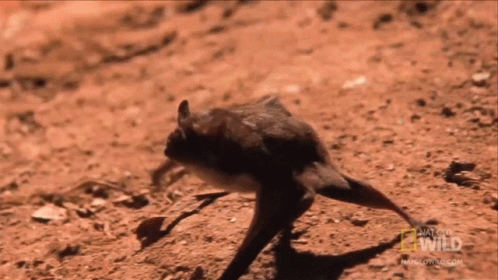
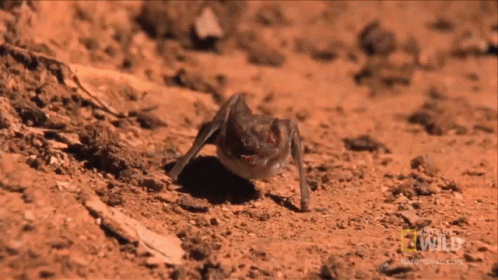
(Common vampire bat walking, running and jumping)
As a paleontology obsessed person, my question now is of course: How the fuck did this happen? What lead to vampire bats having such a specialized lifestyle? This is not an easy questions to answer, mostly because we don‘t have a very good fossil record of bat evolution.
There are many hypothesis that could explain the transition to blood-feeding: They could have fed on insects (or other parasites), that were attracted to the wounds of bigger animals (or caused them), so the bats eventually started feeding on the bigger animal. They could have evolved from already vertebrate-hunting ancestors. They could have started out as nectar-feeders that switched to another liquid. They could have evolved from fruit-eating bats that already had weird teeth for opening fruits (Riskin, 2023).
It does not help that the family vampire bats belong to, the New World Leaf-nosed Bats, are among the most diverse among all mammals, at least in terms of feeding strategies: There are carnivores, omnivores, frugivores (fruit), nectivores (nectar), insectivores (insects), and of course sangivores, the blood-eating vampire bats. In the diagram below you can see how diverse they as a group really are (even just their skulls differ so much from each other), as well as what each bat feeds on.

(family tree of the New World leaf-nosed bats. It is believed that the first 8 branches (Macrotus-Trinycteris) had a common ancestor that look similar to Macrotus/Micronycteris and primarily ate insects and some plant material. The symbols show the main food source for the group (moth = insects; droplet = blood; opossum = vertebrates; flower = nectar; cherry = fruit). (Baker et al, 2012))
Since fossils are rare, scientists look at the species still alive today and compare their DNA with each other. By doing this they can estimate how much time would be needed for all the changes between species to occur. Basically they can look at a family tree like the one above and for each of the branches they can give you a more or less accurate time for when the split happened.
The position of vampire bats in these family trees suggests, that they most likely evolved from an insect-eating ancestor, and all the other feeding strategies evolved after they split from the rest of the group about 26 million years ago. So right now the most likely hypothesis for how blood-feeding evolved is the idea of the bats originally feeding on parasite/insects attracted to the wounds of bigger animals, then deciding to cut out the middleman and go for the bigger animal directly (Raskin 2023, Baker 2012).
Lastely, even though I didn‘t talk about fossils too much, there are some fossil vampire bats that we know of. Most famous is probably Desmodus draculae from the Pleistocene, the biggest known vampire bat ever with a wingspan of about 50 cm - named after the most famous vampire of all time.
11 notes
·
View notes
Text
Genomic insights into metabolic flux in hummingbirds [RESEARCH]
Hummingbirds are very well adapted to sustain efficient and rapid metabolic shifts. They oxidize ingested nectar to directly fuel flight when foraging but have to switch to oxidizing stored lipids derived from ingested sugars during the night or long-distance migratory flights. Understanding how this organism moderates energy turnover is hampered by a lack of information regarding how relevant enzymes differ in sequence, expression, and regulation. To explore these questions, we generated a chromosome-scale genome assembly of the ruby-throated hummingbird (A. colubris) using a combination of long- and short-read sequencing, scaffolding it using existing assemblies. We then used hybrid long- and short-read #RNA sequencing of liver and muscle tissue in fasted and fed metabolic states for a comprehensive transcriptome assembly and annotation. Our genomic and transcriptomic data found positive selection of key metabolic genes in nectivorous avian species and deletion of critical genes (SLC2A4, GCK) involved in glucostasis in other vertebrates. We found expression of a fructose-specific version of SLC2A5 putatively in place of insulin-sensitive SLC2A5, with predicted protein models suggesting affinity for both fructose and glucose. Alternative isoforms may even act to sequester fructose to preclude limitations from transport in metabolism. Finally, we identified differentially expressed genes from fasted and fed hummingbirds, suggesting key pathways for the rapid metabolic switch hummingbirds undergo. http://genome.cshlp.org/cgi/content/short/33/5/703?rss=1&utm_source=dlvr.it&utm_medium=tumblr
0 notes
Photo



psitatrix, more commonly known as a nurse parrot, are nectivorous insectivorous hypercarnivorous omnivores, these omnivorous birds drink nectar from flowering cacti and eat the parasitic insects off of megafauna, more commonly eating the insects than the nectar, they will spend their nights in forests and jungles between deserts and steppes, some lucky nurse parrots will stay in one forest for their whole lives if they are between steppes and deserts, they will build small structures with flowers and bugs for the potential mates, they will then both eat the meal prepared by the nurse parrot then they will both raise their head feathers and then sing and when they both deem each other worthy to mate they will decide which one should lay the eggs through unknown means, and they will be with a single mate for life and the one who lays the eggs will stay in the nest until their kids go away, and then they will do the mating ritual all over again, though still with the same mate, the one who didnt lay eggs is expected to provide food for the nest, they will use their claws to bring parasitic insects back to the nest for the chicks and their mate, if you have any question regarding this bird please dont be afraid to ask
#speculative biology#speculative zoology#speculative evolution#speculative planet#speculative world#spec bio#spec zoo#spec evo#spec planet#spec world#dumuno#exobiology#psitatrix#nurse parrot
4 notes
·
View notes
Text
Blog post #1 - A Walk in the Wild
11/06/2021
Took a short walk along a local water course today. I followed it downstream until the footpath ran out. The water body has been the centre of many recent local environmental improvement schemes, wetland habitat creation, pollution management and river bed modifications, all these works aiming to improve the ecology of the waterway and the surrounding regions.

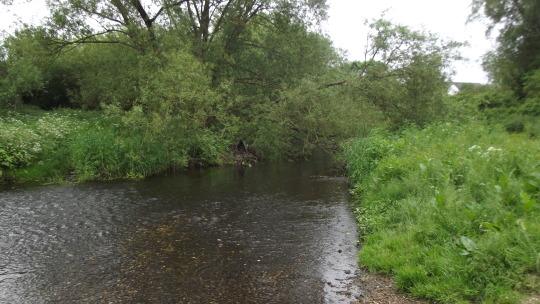


The region is home to a complex plethora of species of flora, too many to list here! A point of interest along the walk was this Crack Willow (Salix fragilis) tree, seeming to have pulled up an area of turf, creating a small undercut in the bank, possible providing shelter to many resident fauna.


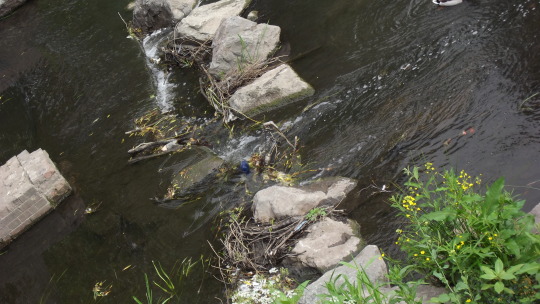
Alot of pollution and debris collected sadly along the water course, though having ran studies of the water quality myself there is no major call for concern, just needs a litter pick!


Many birds spotted along the walk the most abundant being the Mallards ( Anas platyrhynchos). other species of note where Moorhens (Gallinula chloropus), Black-headed gulls (Chroicocephalus ridibundus) and a family of Blue tits (Cyanistes caeruleus), comprised of this years fledglings.
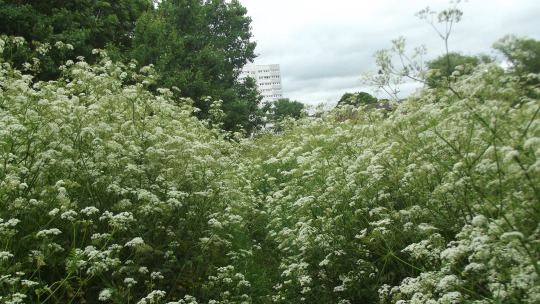
Large areas of dense vegetation have sprung up in the last few weeks along the less travelled parts of the footpath. This region of Cow parsley( Anthriscus sylvestris) was home to a large quantity of nectivorous insects (as well as responsible for turning my black jacket white with pollen!)
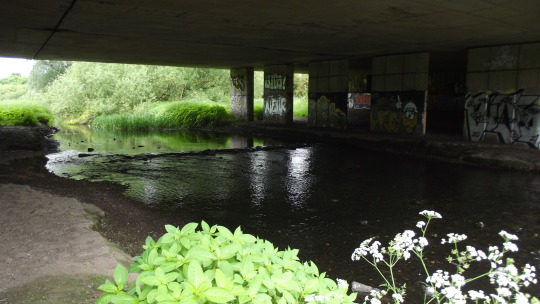
My walk ended with my path being blocked by a fallen tree and a collection of washed up debris by the river, but not before spotting a group of three Wrens (Troglodytes troglodytes) with two Blackbirds (Turdus merula) drinking from along the concreted bank side.


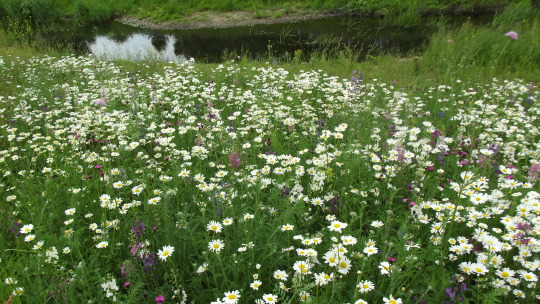
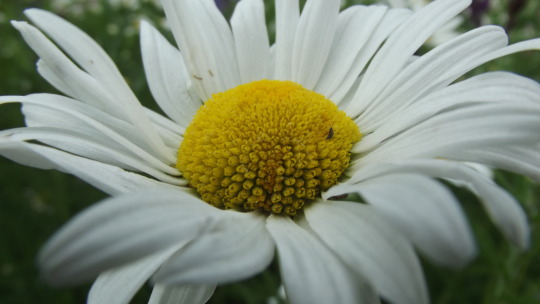
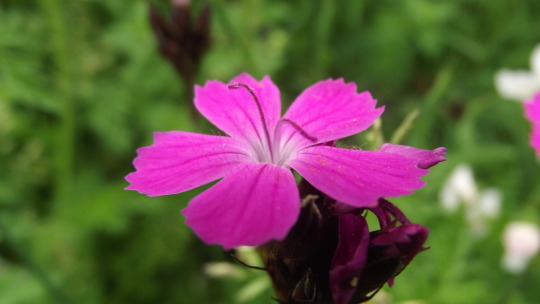


On my return walk, a small deviation along a secondary stream led me to this photogenetic wildflower meadow, no doubt sown by the local volunteer group, filled with native flowers such as Ox-eye daisies (Leucanthemum vulgare) and Red clovers (Trifolium pratense) helping to provide a habitat to bees, butterflies and countless other species, it was a lovely sight to conclude my days journey.
I hope you enjoyed! more posts to come! until next time, I’ll see you in the wildwoods!🌳📸🌳
#ecology#environmental study#environment#thewildwoodsblog#conservationist#naturephotography#nature#riversidewalk#walkinnature#wildlife#urbangreenspaces#natureblog#urbanwildlife
9 notes
·
View notes
Text
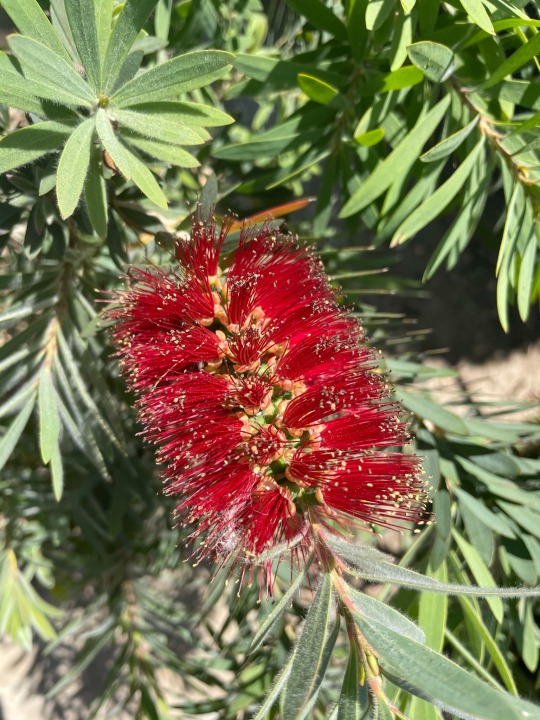
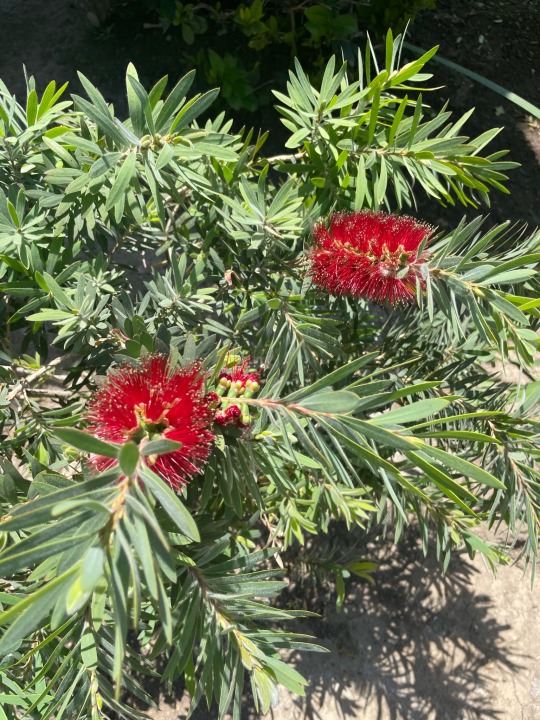
🌺🌸🌼🌻🌺🌸🌼🌻🌺🌸🌼🌻🌺🌸
Day 15.
Today I researched Melaleuca viminalis.
This one was found growing in a residential area of SoCal.
It is commonly known as weeping bottlebrush, or creek bottlebrush. It’s a plant in the myrtle family, Myrtaceae and is endemic to New South Wales, Queensland and Western Australia.
It is a multi-trunked, large shrub or tree with hard bark, often pendulous foliage and large numbers of bright red bottlebrush flowers in spring and summer. It is possibly the most commonly cultivated melaleuca in gardens and its cultivars are often grown in many countries.
Melaleuca viminalis provides food for nectivores. Its adaptations to survive strong currents during flood events allow it to slow the flow of floodwater and reduce erosion, thereby improving the water quality in streams and rivers. The matted roots of this species also strengthen the soil of riverbanks, further reducing the potential for erosion.
🌺🌸🌼🌻🌺🌸🌼🌻🌺🌸🌼🌻🌺🌸
#Melaleuca#Melaleuca Viminalis#Melaleuca Gardens#Bottlebrush#Myrtaceae#Flower#Flowers#Garden#Nature#NaturallyGabakins
4 notes
·
View notes
Text

💐 Hello Flower Followers! 💐
How have you all be enjoying the spotlights so far? We have plenty more to come, so look forward to another one this evening! Until then, today’s FRIDAY FLORAL FACT looks at the usefulness of the Banksia flower:
The plant Banksia is sometimes called “Australian Honeysuckle” because of its ability to produce an impressive amount of nectar. This makes it an important food source for nectivorous creatures such as honey eaters, honey possums, and bats. Beekeepers also seek out banksia specifically to feed their colonies. The animal draw of banksia makes it popular in gardens even though it’s difficult to maintain compared to other Australian flowers and plants!
Sincerely,
💐The Greenhouse Gays Specialists💐
🌈[ Caard (About/FAQ) || Twitter || Instagram || Newsletter ]🌈 🏳️🌈 [ Mods || Contributors ] 🏳️🌈

1 note
·
View note
Text

We see that there's an option to NOT make a terrible pun, now. We shall be testing this.

Siffrin revolts and reviles at the concept of not making puns. Or perhaps at the concept of breaking this nice, comfortable script for this conversation, where they know precisely what to say to make Isabeau happy. It seems like the "favor tree feeling weird" dialogue was a one-time thing, though. Perhaps our favorite dandelion has learned to blend in. We wonder if the "anything weird happen lately" dialogue will differ?











And so it does! We're here later than last time, it seems. Or perhaps Dandelion just muffled their presence faster. Regardless, we're always down to dunk on Loop. Behold, the true form of a star.

Although we aren't aware of an actual parasitic species of firefly, some are cannibalistic, at least to a certain extent. Fireflies are primarily carnivorous as larvae, much like wasps - they eat snails, worms, slugs, and other similar invertebrates. Adult fireflies may be nectivorous, pollen-eating, or eat nothing at all - or they may remain carnivorous, primarily eating other fireflies.
Photuris fireflies in particular have a semi-famous hunting strategy due to this, as females will lure in fireflies of other species through mimicking their mating blinks, then devour them when they land to mate. Through doing this, they will also secure the chemicals that they, themselves, need to power their bioluminescence, thus allowing them to lure more prey in future. We think about them fairly often. Perhaps this is the sign we need to start making weird star-headed firefly art. If we eat Loop, do we gain their glow? Many questions to ask, here.
(Part 23 is here)
All right. Shorter posts appear to work better with website-format blogs, so we're going to try to make these a bit shorter, rather than sticking with the longer, more rambling posts you may be familiar with. At least short enough to not get that one graphical glitch.
(Part 21 is here)

Saying "change" to this door unlocks it! Hooray for very predictable openphrases!

We aren't allowed to take these, apparently, which we think is very rude. What about thyme?



Siffrin is now wanted for the dreadful crime of tampering with someone's mail.





#we speak#liveblog#in stars and time#act 2#loop 3#you will learn about bugs. you have no choice otherwise.
21 notes
·
View notes
Text
What is a Noolbenger?
By John Wible
Noolbenger is the Aboriginal name for the honey possum. So, what is a honey possum? A honey possum, Tarsipes rostratus, is a mouse sized marsupial found in the coastal plains of southwestern Australia. It can only survive in environments where flowers bloom 12 months of the year, because it lives entirely on nectar! They are particularly fond of Banksiaor Australian honeysuckle and are important pollinators. Some bats are also exclusively nectivorous, but their mode of locomotion (i.e., flight) allows them to have large home ranges for feeding. The honey possum accomplishes this entirely on foot at night, scampering from plant to plant. Not surprisingly, it is an adept climber with a prehensile tail acting as a fifth limb. A protrusible tongue with a keratinized brush tip is the main nectar collecting organ. Bucking the usual trend in mammals where males are larger than females, the male honey possum is roughly two-thirds the size of the female.

From John Gould’s The Mammals of Australia (1863).
The Section of Mammals of Carnegie Museum of Natural History has eight specimens of this unusual mammal, which has a very un-mammal-like skull. The bones of the skull are paper thin, reminiscent of a hummingbird skull. It has a long and pointy snout, the better to sniff flowers with. The lower jaw is essentially a thin rod. The upper and lower teeth are reduced in number and size and resemble simple translucent pegs, because you don’t need big complex teeth to grind nectar for digestion. And there is essentially no place on the skull for chewing muscle attachment, again because chewing is not mandatory for feeding.

Tarsipes rostratus, CM 111901.
Honey possums are not considered to be endangered or even threatened. So far, the major concern to their continued existence is wildfires.
John Wible, PhD, is the curator of the Section of Mammals at Carnegie Museum of Natural History. John’s research is focused on the tree of life of mammals, understanding the evolutionary relationships between living and extinct taxa, and how the mammalian fauna on Earth got to be the way it is today. He uses his expertise on the anatomy of living mammals to reconstruct the lifeways of extinct mammals. John lives with his wife and two sons in a house full of cats and rabbits in Ross Township. Museum employees are encouraged to blog about their unique experiences and knowledge gained from working at the museum.
396 notes
·
View notes